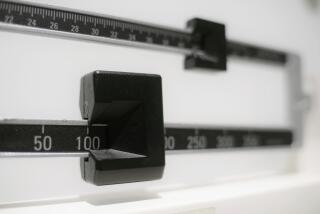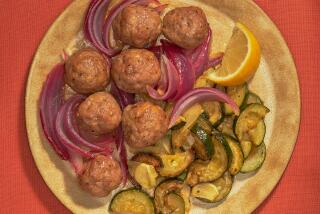Plan Now and Don’t Pay Later : If you think ahead, it’s easy to take along simple healthful snacks and to prepare nutritious dinners fast.
- Share via
If you’re like many people, you want to eat healthy but may think you’re too busy. When time is tight, stopping at a fast-food restaurant or vending machine may seem like your only option--but it’s not.
“You can eat well when you’re on the run, if you just do a little pre-planning,” said Leslie Butz, MS, RD, a dietitian in private practice with Family Medical Center in Mission Viejo. “If you prepare ahead, during the day you can have meals and snacks on hand in your desk, briefcase or car, and in the evening you’ll be able to prepare delicious dinners in less than 30 minutes.”
The new U.S. RDA “food pyramid,” which replaces the four food groups, advocates eating plenty of quick-to-prepare foods. Instead of helping ourselves to so much meat and cheese products, the pyramid says to eat lots of fruits, vegetables, whole grains, including breads and pastas, and beans and peas.
To fit eating healthy into your busy schedule, keep the following tips in mind:
* Start the day right. Breakfast is a highly neglected meal. Thirty-five percent of all Americans skip breakfast entirely, say recent Gallup and Roper polls.
These statistics are alarming to the American Dietetic Assn. because of the many important jobs breakfast performs, including replenishing blood sugar, sharpening brain neurotransmitters and helping maintain weight. (Breakfast-skippers tend to be prone to weight problems).
Sitting down for breakfast may not be an option, but there are many quick things you can do to begin your day on a good nutritional footing.
For those busy days when “dashboard dining” is a necessity, shakes make a great power breakfast. They’re also a healthy option for people who find it difficult to eat something solid in the morning.
Shakes made with tofu pack nutritional punch, said Butz, who has devised a basic recipe that she says her patients really like.
In a blender, mix two ounces of soft tofu, one cup of your favorite juice (exact quantity to be determined by desired consistency), three ice cubes, four pieces of frozen fruit (such as strawberries or blueberries), half of a banana, and for extra fiber, some bran flakes.
“This shake provides the right combination of carbohydrates, protein and fat to keep blood sugar levels at a normal range for several hours, which will keep you satisfied and feeling good,” Butz said.
“You can also buy soy or milk-based protein shakes, but make sure to inspect the ingredient list before purchasing,” said Peggy Krock, a nutritionist based in Santa Barbara who consults with Orange County physicians.
She regularly holds health and weight management seminars for busy professionals throughout Southern California.
“Check shakes for fat content--no more than 3 grams--and fiber--at least 3 grams per serving,” she said.
Other quick, healthy breakfast foods Butz suggests include whole-grain English muffins with a little peanut butter, or a peanut butter and banana sandwich on whole-grain bread.
You can also eat low-fat muffins; low-fat, high fiber protein bars; bagels with low-fat cream cheese, jelly or jam and hard boiled eggs.
If you’re not a big breakfast eater, you might even want to try “non-breakfast foods,” Butz said.
“It’s OK to have a low-fat turkey or chicken sandwich for breakfast or even pizza,” she said. “You don’t have to eat certain foods in the morning. The trick is to start your day off right by eating healthy foods that satisfy you.”
* Select healthy snacks. To soothe mid-morning hunger pangs or even work through lunch, there are a number of satisfying, easily transported snacks that will keep you away from the vending machine or food coach.
Some great briefcase-type snacks include fruit and vegetables.
“Carry along durable fruits such as apples and bananas, which are high-fiber, tasty pick-me-ups,” Butz said. “Carrots are another great choice.”
Granola is also a great snack. “Buy brands without coconut and make sure the nuts aren’t rancid,” she said. “The nut meat should be clear and white, not brown. Granola stays the freshest if you store it in the refrigerator.”
When choosing granola, also check on the fat content. Look for low-fat granolas in health food stores, specialty markets or the diet section of grocery stores. Or make your own. You can toast oats in the oven and add them to almonds, dried fruit and raisins.
Dried cereal also makes a great snack, but beware.
“Don’t assume because a cereal has a healthy name that it is good for you,” Krock said. “Some cereals are extremely high in fat.”
Also check your cereal to make sure that the first ingredient is a whole grain, such as wheat, oats and corn, and stay away from cereals that are high in sugar.
Other easily transported foods include whole-grain crackers topped with peanut butter, unbuttered popcorn and pretzels. Granola bars are a good choice, but, once again, look at the ingredients.
“Many granola bars are very high in fat,” Krock warned. “For instance, one popular bar has 37% fat.” The bar should be no more than 30% fat, which means 3 grams of fat per serving.
* Lunchtime options. “There’s nothing wrong with sandwiches,” Krock said. “Just make sure to choose whole-grain breads and low-fat meats and cheeses. Salads are also a good choice, but be careful of what you put in and on them. Iceberg lettuce contains a mere 1 gram of fiber in an entire head.” Better choices are romaine and spinach. And always go light on the dressing.
If you have a microwave at work, you can heat a number of satisfying lunches.
“Try a baked potato with broccoli and nonfat cottage cheese; beans and rice, or burritos made with whole-wheat tortillas, beans and a little low-fat cheese,” Krock said.
Soup is another quick lunch option. Make your own and add lots of high-fiber beans and legumes. To choose soup from the market, look for those that contain 200 milligrams of sodium or less per serving and avoid products with MSG.
* Meals in minutes. No doubt you’ve stopped for fast food on the way home from a busy day because you’re too tired to cook and don’t want to spend an hour or more in the kitchen.
Some quick and nutritious meals include grilled or baked fish, which cooks in about 10 minutes and is low in fat. Or stir-fry a bunch of vegetables and you have a delicious, healthy topping for rice or pasta. For added flavor, top this with soy sauce or a little fresh grated Parmesan cheese.
“If you make the rice ahead of time, you can put a stir-fry on the table in 30 minutes,” Butz said. Buy frozen pre-cut vegetables or cut them the night before and save even more time.
The crock pot can also be a timesaver.
“In the morning, turn your crock pot on the lowest setting and place thinly sliced vegetables on the bottom and sides and meat on the top; then add water,” Butz said. “Dinner will be ready when you get home.”
* Freeze it. “The key to really saving yourself time in the kitchen is to prepare in bulk and freeze,” Butz said.
Chop up vegetables all at once and freeze them in separate bags that can be pulled out when you want to make a stir-fry, soup or casserole. Fish and other meat can also be packaged and frozen in individual servings, and rice and beans keep well in the freezer.
You may even want to set aside one day or afternoon a month to prepare and freeze meals.
Some good cook-ahead dishes that are easily made in bulk include spaghetti, casseroles, soups and lasagnas. “When making lasagna use low-fat cheeses like mozzarella and Romano, and if you want to add meat, try turkey sausage instead of pork,” Butz said. “Stuffed shells are another great dish and can be topped with pasta sauce when you pull them out of the freezer.”
More to Read
Eat your way across L.A.
Get our weekly Tasting Notes newsletter for reviews, news and more.
You may occasionally receive promotional content from the Los Angeles Times.










